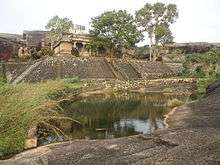Chitharal Jain Monuments
The Chitharal Jain Monuments; also known as Chitharal Malai Kovil (literally Temple on the Hill), Chitharal Cave Temple or Bhagwathi Temple, Chitral; are situated on the Thiruchanattu Malai (Thiruchanattu hillocks) near Chitharal village, Kanyakumari district, Tamil Nadu, India. Chitharal hills are locally known as Chokkanthoongi Hills.[1]
| Chitharal Jain Temple | |
|---|---|
Chitharal Malai Kovil | |
 Chitharal Jain Temple, Tamil Nadu | |
| Religion | |
| Affiliation | Jainism |
| Deity | Tirthankars |
| Location | |
| Location | Marthandam, Kanyakumari district, Tamil Nadu |
| Geographic coordinates | 8°19′57.1″N 77°14′18.2″E |
| Architecture | |
| Date established | 1st century BCE |
| Completed | 6th century AD |
| Temple(s) | 2 |
| Part of a series on |
| Jainism |
|---|
 |
|
Jain prayers |
|
Ethics |
|
Major sects |
|
Texts |
|
Festivals
|
|
|
History

There are two monuments. The earlier rock-cut Jain structure of beads with inscriptions and drip-ledges is the earliest Jain monument in the southernmost part of India which was from first century BC to sixth century AD.[2]
The temple monuments were likely built by Digambara Jains in the ninth century when the region was under influence of Jainism.[3] Jain influence in this region was due to the King Mahendravarman I (610-640).[1]
According to T. A. Gopinatha Rao who visited the monuments in 1920-21, the inscription on the southern side says a Jain priestess called Gunandagi- kurattigal, the disciple of Arattanemi - Bhatariyar of Peravakkudi, presented Bhatariyar of Tiruchchanam malai with a metallic lamp stand and a golden flower during the 28th year of reign of Vikramaditya Varaguna Pandya. It was a Jain training centre for both males and females in past. The inscription is in old Tamil script known as Vatteluthu.[3][4][2]
The Travancore Archaeological Series says that Tiruchcharanattu malai, the name of the hills, means the hill of the Charanas. Charanas means Jain ascetics which were living on the hills. The votive images on the rock with inscription under each of it names an ascetic or person who carved it.[3][2]
It is a centrally protected monument (N-TN-T2) maintained by Thrissur Circle of Archaeological Survey of India since 1964. It is inscribed as Bhagawati temple and Jaina bas-relief.[4][2]
Description
A natural cavern formed by overhanging rock has a bas-relief sculptures of Jain Tirthankaras which were carved in later phase. The relief of Parshwanatha and Padmavati is standing figures canopied by multi-hooded cobra and with attendant figures of Yaksha. The figures seated in ardha-padmasana pose in each niches with three tiered parasol is that of other Tirthankaras (possibly of all 24 Tithankaras). there are three standing figures of Tirthankara in on of the left corner. The central niche has a figure of Mahavira with three tiered parasol, chhatratrayi chaitya with a tree above it and attendant figures. There is another female figure of Ambika in a niche next to it. It has attendant figures including two children and a lion mount. All major niches has flying figures of Vidyadharas or worshippers. Each of this figures has a short inscription below the seat mentioning a name of donor and place in Vatteluthu Tamil script. Based on these inscription, it is known that the site was under control of Jains at least till middle of thirteenth century.[2][3][4]
The monuments are reached by roughly hewn steps in rocks and the narrow entrance between them. On the top of the hill, there in a cave temple with mandapa, a varandah corridor and a balipeetham with a kitchen (madappalli) which is carved into a natural overhanging rock facing the west. It has three sanctums which houses the Tirthankara (possibly Mahavira) in middle, goddess in the right and Parshwanatha on the left. The gopuram of the central shrine is destroyed possibly due to lightning. The temple was built in medieval period. There is another temple-like structure (Vimana) on the top of the hill which is reached by climbing few steps. There is a natural pond few steps downwards.[3][5][6][7] Around 13th century, the cave temple was converted into Hindu temple of Bhagavati.[3][1] It is known by the Tamil script inscription on the entrance of the mandapa dated to 475 KE (1300 AD) which says Narayanan, Tamil Appalla Varaiyan of Rajavallapuram in the Kil Vembanadu donated some money for the expense of Bhagavati temple.[4]
Gallery
 Entrance of cave temple
Entrance of cave temple Cave temple side view
Cave temple side view- Cave temple from distance
 Cave temple from distance
Cave temple from distance Destroyed Vimana
Destroyed Vimana Destroyed Vimana
Destroyed Vimana Jain bas relief
Jain bas relief- Jain bas-relief
 Jain bas-relief
Jain bas-relief Jain bas-relief
Jain bas-relief Jain bas-relief
Jain bas-relief Jain bas-relief
Jain bas-relief Jain bas-relief
Jain bas-relief
See also
References
- "Chitharal". Tamil Nadu Tourism. Retrieved 23 March 2017.
- "Bagawati Temple (Chitral)". Thrissur Circle, Archaeological Survey of India. Archived from the original on 19 March 2016. Retrieved 23 March 2017.
- Nagarajan, Saraswathy (17 November 2011). "On the southern tip of India, a village steeped in the past". The Hindu. Retrieved 23 March 2017.
- http://4.bp.blogspot.com/-YrAUaXmP6q8/URNs5F8uoUI/AAAAAAAAELU/9tW_MqcIdfY/s1600/krishnasepages.blogspot.com_14ChitharalRockcutTemple.JPG
- Anon (2005). Tourist Guide to South India. Sura Books. pp. 128–129.
- Rangarajan, H; Kamalakar, G; Reddy, AKVS; Venkatachalam, K (2001). Jainism: Art, Architecture, Literature & Philosophy. Sharada. p. 43.
- Shah, Umakant P (1987). Jaina Iconography. Abhinav Publications. p. 251.
| Wikimedia Commons has media related to Chitharal Jain Monuments. |
- The Travancore gazette dated 4 November 1931